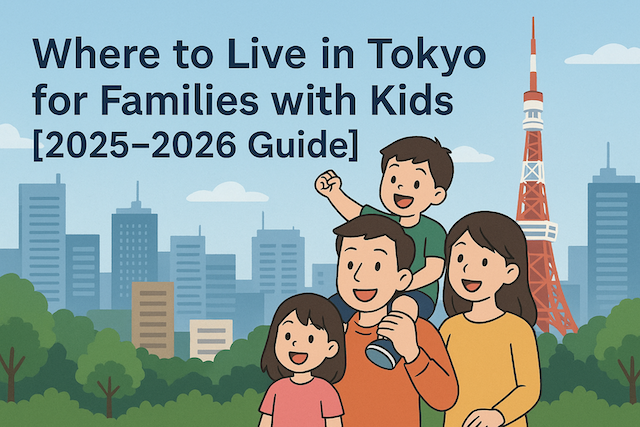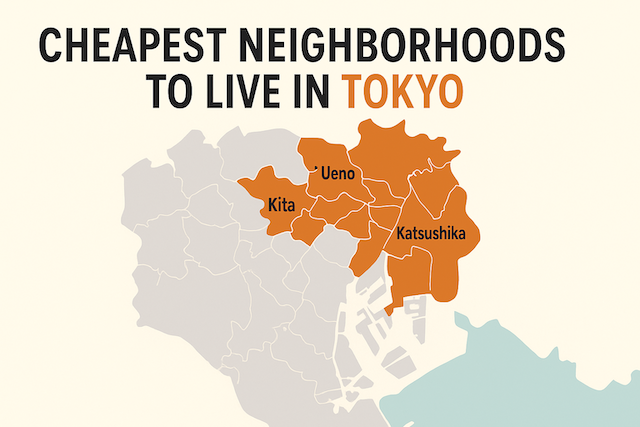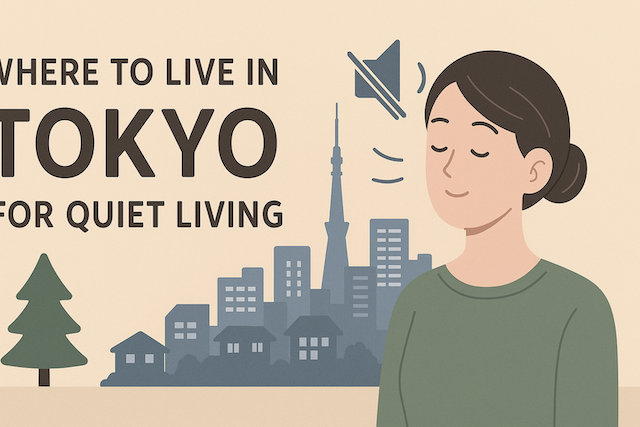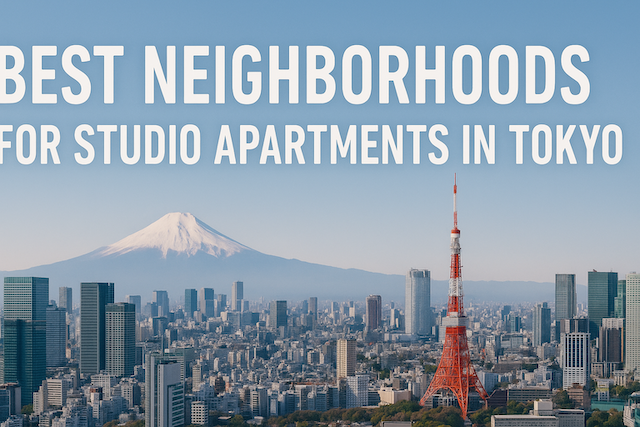Where to Live in Tokyo for Families with Kids [2025–2026 Guide]
Tokyo is one of the safest and most convenient cities in the world, making it an excellent place to raise children. However, with its vast size and diverse neighborhoods, choosing where to live as a family can feel overwhelming. Each area offers a different lifestyle, from international schools and parks to child-friendly restaurants and easy access to transportation. In this guide, we’ll explore the best places to live in Tokyo for families with kids — focusing on safety, education, green spaces, and community atmosphere.
Azabu, Minato Ward – International and Prestigious
Azabu (including Azabujuban, Moto-Azabu, and Higashi-Azabu) is one of Tokyo’s most popular neighborhoods among expat families. The area combines luxury living with a warm, international community atmosphere.
Why Families Love It:
-
Top-tier international schools such as Nishimachi International School and the International School of the Sacred Heart are nearby.
-
Despite being central, Azabu’s residential streets are calm and well-patrolled.
-
Families from many countries live here, making it easy to form international friendships.
Drawbacks:
Rent prices are high, and housing is often limited to modern apartments rather than large houses.
Average Rent (2025–2026):
3LDK family apartment: ¥650,000–¥900,000/month
Hiroo, Shibuya Ward – Central Yet Family-Oriented
Hiroo is another favorite among families, offering a blend of urban convenience and suburban peace. It’s within walking distance of Roppongi and Ebisu, yet feels calm and leafy.
Why Families Love It:
-
Excellent international schools such as the British School in Tokyo (Shibuya campus) and Montessori options.
-
Arisugawa-no-miya Memorial Park is perfect for picnics, playgrounds, and duck feeding.
-
English-friendly area with many clinics, cafes, and shops catering to foreigners.
Drawbacks:
High living costs and limited parking spaces.
Average Rent (2025–2026):
3LDK apartment: ¥600,000–¥850,000/month
Denenchofu, Ota Ward – Tokyo’s “Beverly Hills” for Families
Denenchofu offers a suburban, European-style lifestyle with beautiful homes, wide streets, and excellent schools. It’s ideal for families seeking space and tranquility.
Why Families Love It:
-
Spacious detached houses with gardens.
-
Near Seisen International School and Denenchofu Futaba.
-
Easy access to Tama River and family-friendly parks.
Drawbacks:
Commute to central Tokyo can take 40–60 minutes.
Average Rent (2025–2026):
4LDK house: ¥500,000–¥900,000/month
Meguro Ward – Balance of Greenery and Urban Comfort
Meguro is one of Tokyo’s most balanced areas — safe, residential, and filled with parks, yet close to major business districts. Popular neighborhoods include Nakameguro and Yutenji.
Why Families Love It:
-
Friendly community with both Japanese and expat families.
-
Access to respected local and international schools.
-
Green areas like Meguro River and Komazawa Olympic Park nearby.
Drawbacks:
Housing can be compact, especially around Nakameguro.
Average Rent (2025–2026):
3LDK apartment: ¥400,000–¥650,000/month
Setagaya Ward – Green, Spacious, and Community-Focused
Setagaya is one of Tokyo’s largest and most family-friendly wards. It’s known for good local schools, safety, and a suburban feel while remaining connected to central Tokyo.
Why Families Love It:
-
Houses and large apartments at more reasonable prices.
-
Many parks including Setagaya Park and Komazawa Olympic Park.
-
Warm, community-oriented neighborhoods.
Drawbacks:
Slightly farther from central districts compared to Minato or Shibuya.
Average Rent (2025–2026):
3LDK apartment: ¥350,000–¥600,000/month
Kichijoji, Musashino City – Family Life Meets Creativity
Kichijoji is consistently ranked as one of Tokyo’s most desirable residential areas. It combines greenery, culture, and convenience.
Why Families Love It:
-
Inokashira Park offers playgrounds, a zoo, and boat rides.
-
Great mix of shopping, cafes, and entertainment.
-
Excellent local schools and safe neighborhoods.
Drawbacks:
Longer commute to business districts (30–40 minutes).
Average Rent (2025–2026):
3LDK apartment: ¥300,000–¥500,000/month
Jiyugaoka, Meguro/Setagaya Border – Relaxed European Atmosphere
Jiyugaoka is known for its elegant cafes, boutiques, and peaceful streets. It’s perfect for families who want both comfort and charm.
Why Families Love It:
-
Relaxed, walkable streets and organic markets.
-
Safe and quiet environment.
-
Access to Seisen International School and several preschools.
Drawbacks:
Less nightlife and fewer large parks nearby.
Average Rent (2025–2026):
3LDK apartment: ¥400,000–¥600,000/month
Toyosu, Koto Ward – Modern Family Living by the Bay
Toyosu is a modern, master-planned neighborhood designed for families. It offers safety, convenience, and plenty of recreational facilities.
Why Families Love It:
-
New, spacious apartments with on-site playgrounds.
-
Many daycare centers and bilingual preschools.
-
Easy access to shopping centers like Lalaport Toyosu.
Drawbacks:
Some families find it too modern or lacking in cultural charm.
Average Rent (2025–2026):
3LDK apartment: ¥350,000–¥550,000/month
Musashi-Kosugi, Kawasaki – Affordable Yet Accessible
Located just outside Tokyo, Musashi-Kosugi offers modern living at more affordable prices. It’s perfect for families wanting space without losing access to central Tokyo.
Why Families Love It:
-
Large high-rise condos with family-friendly layouts.
-
15–20 minutes to Shibuya or Tokyo Station.
-
Safe and growing bilingual community.
Drawbacks:
Tower apartments can feel impersonal for some families.
Average Rent (2025–2026):
3LDK apartment: ¥280,000–¥450,000/month
Recommendations Based on Priorities
| Family Priority | Recommended Areas | Notes |
|---|---|---|
| Top International Schools | Azabu, Hiroo, Denenchofu | Short commute to major schools |
| Spacious Homes | Setagaya, Denenchofu, Musashi-Kosugi | Ideal for larger families |
| Green Spaces & Parks | Kichijoji, Setagaya, Toyosu | Great for young children |
| Budget-Friendly Yet Safe | Musashi-Kosugi, Kichijoji | Affordable and family-oriented |
| Urban Lifestyle with Family Comfort | Hiroo, Meguro, Jiyugaoka | Central but calm |
Conclusion
Tokyo offers a wide range of neighborhoods that suit different family lifestyles — from the international prestige of Azabu and Hiroo to the greenery of Setagaya and Kichijoji. Families who value safety, education, and community will find their ideal environment with careful selection. Whether you prefer the cosmopolitan energy of central Tokyo or the relaxed charm of its suburbs, living in Tokyo with kids in 2025–2026 can be both enriching and fulfilling.
FAQs
What are the best neighborhoods in Tokyo for families with kids in 2025-2026?
Top family picks include Azabu and Hiroo (central, international, close to major schools), Denenchofu (quiet, houses with gardens), Setagaya (green, community-focused, larger floor plans), Meguro and Jiyugaoka (balanced urban comfort and charm), Toyosu (new, master-planned, kid-friendly facilities), Kichijoji (parks and creative vibe), and Musashi-Kosugi just outside Tokyo (more space, strong transport links). Your ideal choice depends on priorities like school access, commute time, and desired housing size.
How should I prioritize factors when choosing a family neighborhood?
Use a simple hierarchy: (1) school commute (door-to-door within 30 minutes if possible), (2) daily life radius (parks, groceries, clinics within a 10–15 minute walk), (3) adult commute (avoid >50 minutes one-way), (4) housing size and layout (separate bedrooms, storage), and (5) budget. Then test the area at your actual routine times—school drop-off, grocery runs, and your commute window—before signing.
Which areas are closest to international schools?
Azabu, Hiroo, and Roppongi surround several long-established international schools and preschools. Denenchofu and Jiyugaoka work well for families linked to schools along the Tokyu lines (e.g., toward Seisen). Toyosu and Koto Ward have growing options for bilingual preschools. Always map the exact campus your child will attend in 2025-2026, as some schools maintain multiple sites or shuttle routes.
How much rent should a family expect to budget in 2025-2026?
As a broad guideline, central 3LDK apartments can range from upper mid to premium levels, while Setagaya, Kichijoji, and Musashi-Kosugi tend to offer comparatively better space for the price. High-rise, newer units command a premium; low-rise or older stock may be more budget-friendly. Add building management fees, parking (if any), key money, deposit, and agency fees to your total first-year cost model.
Is Tokyo safe for kids, and which areas feel most family-friendly?
Tokyo is one of the world’s safest big cities, and most residential wards are comfortable for families. Areas like Setagaya, Denenchofu, and Kichijoji offer calm streets and abundant parks. Toyosu provides wide sidewalks and planned open spaces. Even central districts like Azabu and Hiroo maintain a neighborhood feel on backstreets. As always, verify your building’s earthquake standards and the walking route to school.
What layouts work best for families (2–3 bedrooms vs. 3–4 bedrooms)?
For one young child, a 2LDK can suffice if living and dining areas are efficient and storage is strong. For two kids or frequent guests, a 3LDK offers flexibility for a playroom or office. Families with teens or multigenerational setups may need 4LDK or a house. Check ceiling height, closet volume, stroller parking, bicycle storage, and whether bedrooms can fit full-size beds plus desks.
House vs. apartment: what’s better for families?
Houses (common in Denenchofu and parts of Setagaya) provide privacy, storage, and sometimes a small garden. Trade-offs include longer commutes, more maintenance, and fewer on-site amenities. Apartments—especially newer high-rises in Toyosu or Musashi-Kosugi—offer elevators, security, playrooms, and convenience stores downstairs, but bedrooms can be smaller. Consider noise tolerance, pet policies, and stroller access.
How do I reduce commute stress for both parents and kids?
Anchor your search around the school’s station and the parent with the least flexible work schedule. Choose a line with minimal transfers and platforms near elevators. If you expect overtime or late calls, prioritize shorter adult commutes and a babysitter network near home. For younger kids, being within walking or short bus distance of school in 2025-2026 can dramatically improve daily quality of life.
Are there family-friendly amenities I should look for nearby?
Prioritize parks with playgrounds, pediatric clinics, supermarkets with delivery, after-school activities, libraries, and community centers. Indoor play facilities and sports clubs are major bonuses for rainy days. In high-rises, check for shared kids’ rooms, rooftop gardens, and multipurpose halls. In low-rise areas, scout local shotengai (shopping streets) for daily convenience and community events.
What should expat families know about language and healthcare?
In Azabu, Hiroo, and central hubs, you’ll find many English-capable clinics and dentists. Elsewhere, pharmacies and hospitals may be Japanese-first, but translation apps and appointment prep help. For emergencies, know your nearest ER and how to describe symptoms. If language is a concern, pick neighborhoods known for international communities or join local parent groups that share vetted providers.
How do earthquake safety and building codes factor into the decision?
Ask the landlord or agent for the building’s construction year and standards; newer properties typically follow stricter codes. Corner units and higher floors can feel more sway in tall towers; low to mid floors may feel calmer. Secure furniture, use anti-tip brackets, and plan family meet-up points. Proximity to wide evacuation routes and local shelters is another practical filter.
Can we find furnished or partially furnished family rentals?
Yes, but choice narrows as size increases. Many furnished listings target singles or couples. For families, serviced apartments near central Tokyo offer turnkey options (at a premium) suitable for the first 1–3 months while you house-hunt. Otherwise, consider partially furnished units (appliances included) and arrange furniture via rental services, buy-nothing groups, or secondhand marketplaces.
What’s a realistic timeline to secure a family home in 2025-2026?
From shortlisting to move-in, plan 6–10 weeks. Add time if you’re applying to multiple schools, importing pets, or waiting on residence cards and bank accounts. Competitive areas near top schools can move fast; have your documents, employer letter, and budget approvals ready. If relocating in peak seasons (March–April, August–September), consider temporary housing as a bridge.
How can we optimize our budget without sacrificing safety or comfort?
Trade a 10–15 minute longer adult commute for larger, newer units in Setagaya, Koto, or Musashi-Kosugi. Choose low-rise or slightly older buildings with strong maintenance records. Target units facing quieter streets instead of premium view sides. Negotiate for minor upgrades (blackout shades, extra AC maintenance) or included appliances. Annual rent negotiations may be possible on renewals.
Are pets feasible in family neighborhoods?
Yes, but check pet-friendly clauses carefully. High-rises may cap pet size or limit numbers; some houses are more flexible. Look for nearby green spaces and pet clinics, and confirm elevator etiquette rules. In compact layouts, prioritize storage for crates and supplies. Pet deposits or extra cleaning fees are common; factor these into total cost.
What is the best way to shortlist neighborhoods fast?
Create three non-negotiables (e.g., school within 25 minutes, 3 bedrooms, under a set budget) and three “nice-to-haves” (e.g., park within 8 minutes, balcony, on-site playroom). Plot 3–5 candidate areas that meet your non-negotiables, then schedule back-to-back viewing days during rush hour and school run times. Keep a scoring sheet for each home to compare objectively.
How do seasons and weather affect daily family life?
Tokyo summers are hot and humid; prioritize shade, indoor play options, and strong AC. Spring and autumn are ideal for park time in Setagaya and Kichijoji. In winter, proximity to indoor pools, gyms, or community centers is helpful. Covered arcades (shotengai) make rainy-day errands easier, and buildings with stroller-friendly entrances reduce daily friction year-round.
Should we live inside Tokyo or just outside (e.g., Musashi-Kosugi)?
Inside Tokyo (Azabu, Hiroo, Meguro) means shorter school and work commutes and strong English-friendly infrastructure, but higher prices and smaller floor plans. Just outside (Musashi-Kosugi, parts of Kawasaki and Chofu) offers more space, newer towers, and family amenities at better value. If one parent works from home, the extra space often outweighs the marginally longer city trips.
What documents and costs should we prepare before applying?
Have ID/residence card (once issued), employment letter, income proof, and guarantor/guarantor company approval. Budget for deposit, key money (if applicable), agency fee, lock change, first month’s rent, and insurance. If using a school bus, include monthly fees in your housing decision. For 2025-2026, keep a buffer for exchange-rate swings and initial furnishing.
Bottom line: how do we pick confidently for 2025-2026?
Start with the school map, then overlay commute and lifestyle needs. Tour 6–10 units across 2–3 neighborhoods that hit your non-negotiables. Pressure-test the daily routine at real times, verify building safety and noise, and speak with neighbors or parent groups. When two options tie, choose the one with the smoother school commute and better everyday amenities—you’ll feel the benefit every single day.
https://tokyorelocationguide.com/neighborhoods/




![Where to Live in Tokyo for Students [2025–2026 Guide]](https://tokyorelocationguide.com/wp-content/uploads/2025/10/ChatGPT-Image-Oct-17-2025-04_32_25-PM.png)


![Where to Live in Tokyo for Expats [2025-2026 Guide]](https://tokyorelocationguide.com/wp-content/uploads/2025/10/ChatGPT-Image-Oct-17-2025-03_50_34-PM.png)